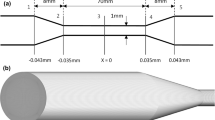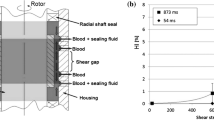Abstract
Congestive Heart Failure is a cardiovascular disease with global incidence and high mortality. In advanced stages, when patients are already refractory to drug therapies, there are two main alternatives, the heart transplantation, or the mechanical circulatory support. Ventricular Assist Devices are blood pumps designed to circulate blood in physiological conditions. Thus, hemolysis prediction is indispensable in VAD development. In literature, there are several models based on scalar stress analysis for estimating hemolysis index. Here, a different kind of analysis based on stress distribution and critical stress is proposed. Simulations were performed in a VAD prototype and 5 turbulence models were tested. Results show the distribution of scalar stress magnitudes according to their volume distribution and an important discussion and qualitative analyses were made, despite overall scalar stress measurements which generalize the results.
Access this chapter
Tax calculation will be finalised at checkout
Purchases are for personal use only
Similar content being viewed by others
References
Kormos RL, Cowger J, Pagani FD et al (2019) The society of thoracic surgeons intermacs database annual report: evolving indications, outcomes, and scientific partnerships. Ann Thorac Surg 107(2):341–353
Gross-Hardt S, Sonntag SJ, Boehning F et al (2019) Crucial aspects for using computational fluid dynamics as a predictive evaluation tool for blood pumps. ASAIO J 1
Souza RL, Chabu IE, Da Silva ED et al (2019) A strategy for designing of customized electromechanical actuators of blood pumps. Artif Organs. https://doi.org/10.1111/aor.13556
Taskin ME, Frase KH, Zhang T et al (2012) Evaluation of eulerian and lagrangian models for hemolysis estimation. Biomed Eng ASAIO 363–372
Song X, Wood HG, Day SW et al (2003) Studies of turbulence models in a computational fluid dynamics model of a blood pump. Artif Organs 27(10):935–937. https://doi.org/10.1046/j.1525-1594.2003.00025.x
Fraser KH, Zhang T, Taskin ME et al. (2012) A quantitative comparison of mechanical blood damage parameters in rotary ventricular assist devices: shear stress, exposure time and hemolysis index. J Biomech Eng 134:081002-1–081002-11. https://doi.org/10.1115/1.4007092
Giersiepen M, Wurzinger LJ, Opitz R et al (1990) Estimation of shear stress related blood damage in heart valve prostheses: in vitro comparison of 25 aortic valves. Int J Artif Organs 13(5):300–306
Grigioni M, Moubuducci U, D’avenio G et al (2005) A novel formulation for blood trauma prediction by a modified power-law mathematical model. Biomechan Model Mechanobiology 4:249–260. https://doi.org/10.1007/s10237-005-0005-y
Faghih MM, Sharp MK (2016) Extending the power-law hemolysis model to complex flows. J Biomechan Eng 138. https://doi.org/10.1115/1.4034786
Tamagawa M, Minakawa S (2003) Predictions of index of hemolysis in shear blood flow (effects of exposure time under shear stress and prediction accuracy). JSME Int J 46(2):604–613. https://doi.org/10.1299/jsmec.46.604
Arvand A, Hormes M, Reul H (2005) A validated computational fluid dynamics model to estimate hemolysis in a rotary blood pump. Artif Organs 29(7):531–540. https://doi.org/10.1111/j.1525-1594.2005.29089.x
Lopes Jr GB (2016) Computational analyses methodology for blood flow in ventricular assist devices. Thesis PhD, Escola de Engenharia de São Carlos, Universidade de São Paulo, São Carlos
Bock E, Ribeiro A, Silva M et al (2008) New centrifugal blood pump with dual impeller and double pivot bearing system: wear evaluation in bearing system, performance tests, and preliminary hemolysis tests. Artif Organs 32(4):329–333. https://doi.org/10.1111/j.1525-1594.2008.00550.x
Lopes GB Jr, Gómez LC, Bock EGP (2016) Mesh independency analyses and grid density estimation for ventricular assist devices in multiple reference frames simulations. Technische Mechanik 36(3):190–198. https://doi.org/10.24352/UB.OVGU-2017-0005
Lopes GB Jr, Gómez LC, Bock EGP (2016) Numerical analyses for low reynolds flow in a ventricular assist device. Artif Organs. https://doi.org/10.1111/aor.12776
ANSYS INC (2011) Ansys fluent theory guide. v 14
Acknowledgements
We thank CNPq, CAPES, Federal University of Pernambuco, São Paulo Federal Institute of Technology and University of São Paulo staff for all support during the studies that resulted in the present work.
Conflict of Interest
The authors declare that they have no conflict of interest.
Author information
Authors and Affiliations
Corresponding author
Editor information
Editors and Affiliations
Rights and permissions
Copyright information
© 2022 Springer Nature Switzerland AG
About this paper
Cite this paper
Lopes, G.B., Bock, E.G.P., Cabezas-Gómez, L. (2022). Qualitative Hemolysis Analyses in VAD by Stress Distribution Using Computational Hemodynamics. In: Bastos-Filho, T.F., de Oliveira Caldeira, E.M., Frizera-Neto, A. (eds) XXVII Brazilian Congress on Biomedical Engineering. CBEB 2020. IFMBE Proceedings, vol 83. Springer, Cham. https://doi.org/10.1007/978-3-030-70601-2_36
Download citation
DOI: https://doi.org/10.1007/978-3-030-70601-2_36
Published:
Publisher Name: Springer, Cham
Print ISBN: 978-3-030-70600-5
Online ISBN: 978-3-030-70601-2
eBook Packages: EngineeringEngineering (R0)




